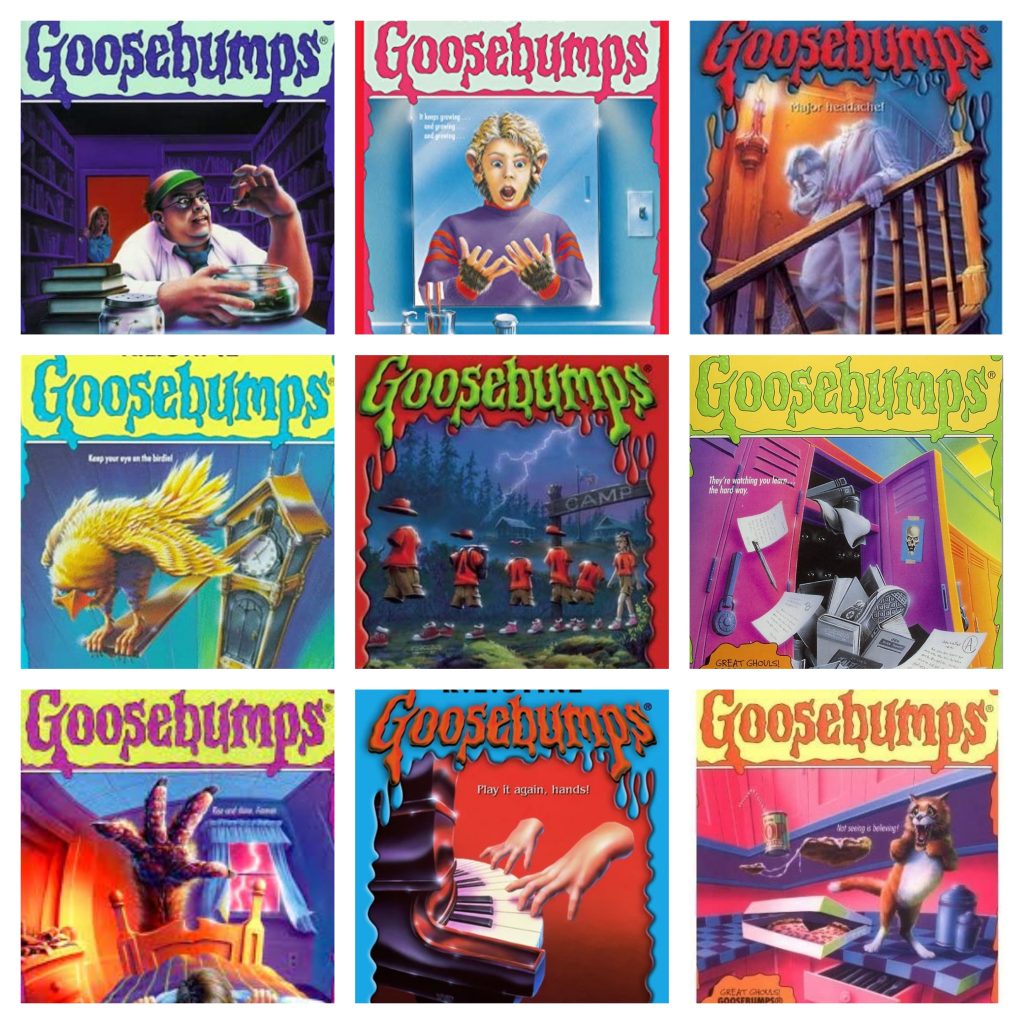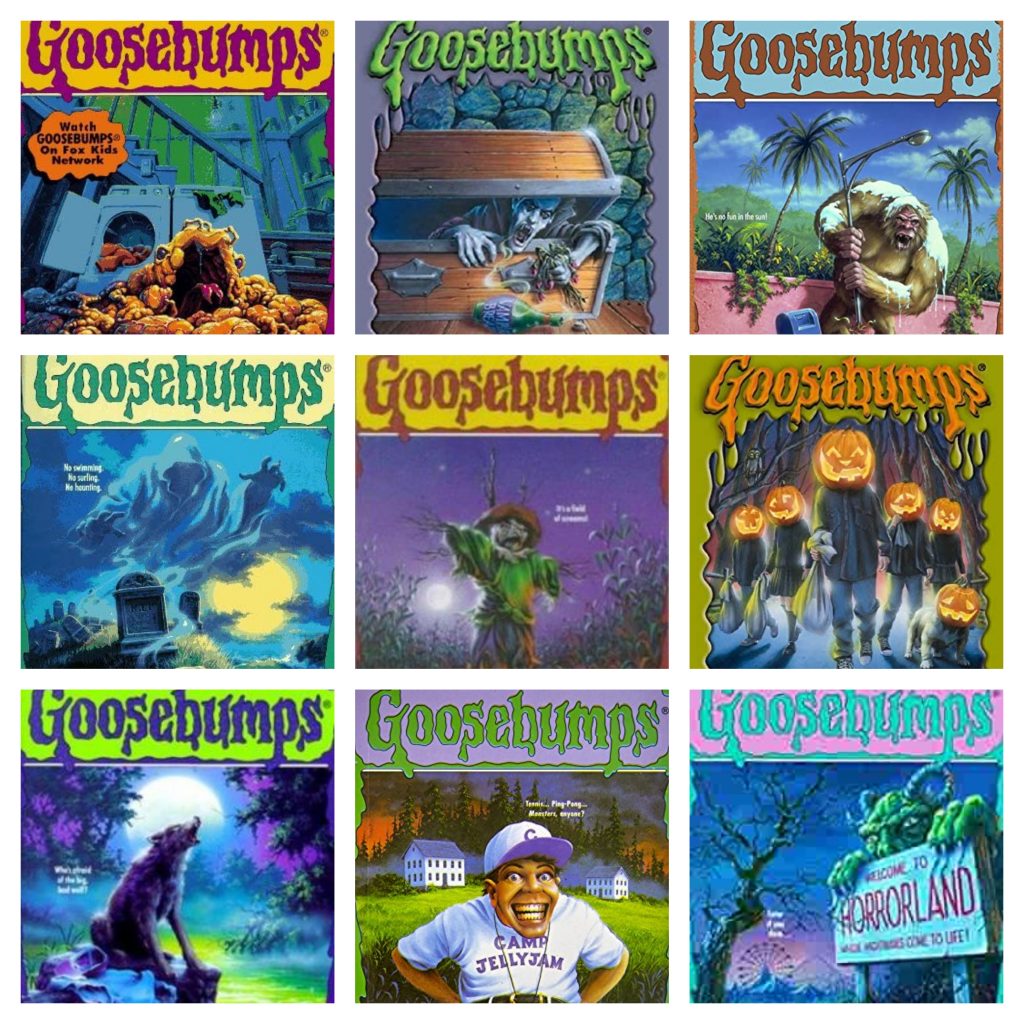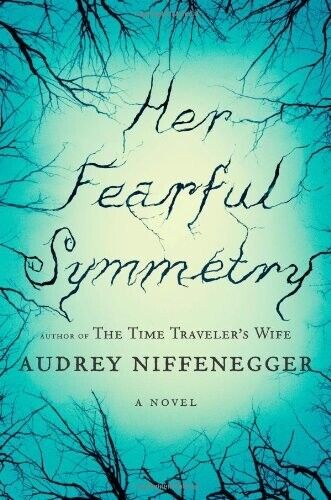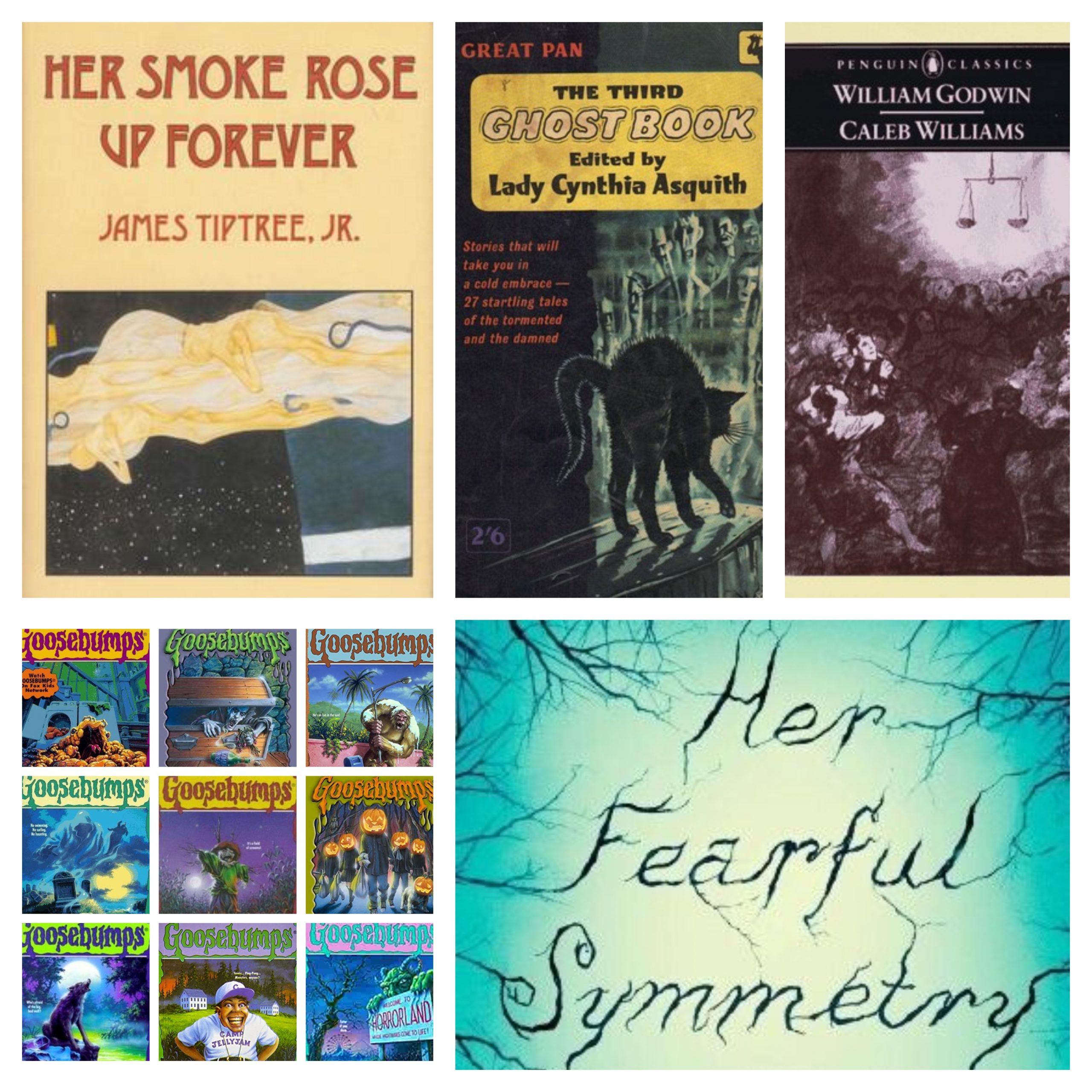This entry marks a momentous occasion. I have officially finished going through all of the original 62 Goosebumps books! (And NO, I am not reading the spin-off series). Oh, I read some other stuff too like a collection of feminist sci-fi, an influential crime novel from the 18th century, a quirky modern day ghost story involving twins and a collection of decidedly very British stories of the supernatural.
For those just joining me, this is my journey through the following “Best of” Horror lists:
Reedsy Discovery Best Horror Books
Stephen Jones & Kim Newman’s Horror: 100 Best Books
Stephen Jones & Kim Newman Horror: Another 100 Books
If you want to check out my previous entries, they can be found here:
Part 34 | Part 33 | Part 32 | Part 31 | Part 30 | Part 29 | Part 28 | Part 27 | Part 26 | Part 25 | Part 24 | Part 23 | Part 22 | Part 21 | Part 20 | Part 19 | Part 18 | Part 17 | Part 16 | Part 15 | Part 14 | Part 13 | Part 12 | Part 11 | Part 10 | Part 9 | Part 8 | Part 7 | Part 6 |Part 5 | Part 4 | Part 3 | Part 2 | Part 1
Reader beware! You’re in for a scare!

Her Smoke Rose Up Forever (James Tiptree Jr., 1990)
List: NPR (includes the story “The Screwfly Solution” collected in this book)
Alice Sheldon, better known under her pseudonym James Tiptree Jr., was a celebrated writer of progressive science fiction, often embedding feminist themes into the subtext of her stories, so much so to the point that I wondered why it took so long before the true identity of James Tiptree was discovered. Her story “The Screwfly Solution” is the tale in particular that was included on NPR’s best horror, and it’s a very disturbing vision of a future in which all men are infected with a virus that drives them to insane violence toward women. It’s a bleak story told in a very matter-of-fact way that punctuates the disturbing nature of it. Beyond that, this collection does lean more in the pure sci-fi realm, but several of the stories involve violence against women as a catalyst for a journey of discovery or reinvention. Her stories also deal heavily in the philosophical nature of human existence and man’s place in a world unfamiliar to them.
“Houston, Houston, Do You Read?” is one of the more well-known stories in this collection, having won both the Hugo and Nebula awards the year it was released, and is one of the better stories here. It involves a crew of male astronauts who due to a spatial anomaly are catapulted 500 years into the future and are confronted by a seemingly predominantly female society. It goes to some very dark places and may come across preachy or even sexist, but it’s still a powerful piece of writing that embodies what sci-fi is all about. “With Delicate Mad Hands” is another interesting novella that chronicles a woman aboard a spaceship who is used and abused by her superiors until she snaps and kills them, afterward crash-landing on a planet uninhabitable by humans. It’s a story that shifts theme and tone multiple times and illustrates both the anger and the beauty and the heart of Sheldon’s writing. Also perhaps the story with the most overt horror elements is another novella, “A Momentary Taste of Being”, about the discovery of a seemingly idyllic planet suited to human habitation that proves to be much more terrifying than anyone imagined. I also quite liked the story “Slow Music”, about two of the last people on Earth who haven’t “gone up the river” along with the rest of humanity. One is a man set on heading to the river to fulfill a promise to his father. The other is a woman who actively does not want to go to the river and wants to remain on Earth and raise children. I just thought the writing in this one was particularly good for whatever reason despite the extremely frustrating ending.
A few of these I wasn’t the biggest fan of due to how obfuscated the narratives were for one reason or another. I found “Love Is the Plan the Plan is Death” pretty frustrating to read due to the writing style employed, a style that mimics the thoughts and speech of an alien species. It’s a shame because the idea of the story itself is quite good. “The Girl Who Was Plugged In” is another one that’s a little annoying to read, loaded down with future slang, but on the whole is still rooted in a humanity that helps it flow better than the prior story.
Overall, I actually liked this collection quite a bit and Sheldon’s writing skills are some of the best in the science fiction realm I’ve ever come across. Definitely recommended if you like the more subtextual, thought-provoking sci-fi.

Caleb Williams (William Godwin, 1794)
List: Jones/Newman
Caleb Williams is a humble servant of the powerful but seemingly benevolent master Falkland, a nobleman who harbors a dark secret. The first third of the book is taken up with the history of Falkland and a rival by the name of Tyrrel who is a cold and bitter member of the upper crust who destroys a young woman with whom Falkland is enamored through his calculated menace and his desire to spite the young upstart Falkland. One evening, Tyrrel and Falkland have a heated altercation ending with Tyrrel knocking Falkland to the floor.
Not long after, Tyrrel is found beaten to death in the street. Falkland is never suspected since he of the gentry, and so another man is sent to the gallows for the crime. When Caleb stumbles across some evidence that eludes to Falkland’s true actions that night, he avows never to reveal it, so beloved does he hold his master’s reputation. Yet Falkland takes a mighty retaliation out on him anyway, seeking to ruin his life completely.
For those unaware, William Godwin has an interesting history. He was a major crusader for justice against the ruling class with this novel being an indictment of such, and he married renowned feminist writer Mary Wollencraft. Their daughter would grow up to be Mary Shelley, author of the seminal novel Frankenstein. That’s a pretty potent lineage, eh? Anyway, while Caleb Williams (both novel and character) is prone to random overly naive pleas of mercy to those in power which is mostly ignored due to his low standing (and which grows rather tedious after the hundredth time it happens), the book has a surprisingly brisk pacing at times, particularly after the back story of the first third. Once Caleb goes on the lamb, I was quite engaged in his desperate escapades to evade capture and prove his innocence. While Caleb Williams is by no means a horror novel, it does serve as an early and quite good example of the crime thriller which would act as a major influence on the horror genre as a whole. Some out there may balk at the time in which this was written, fearing it to be a ponderous, dense read. But honestly while the prose is a bit archaic at times, it’s actually a breezier read than some novels I’ve read from a hundred years later (I’m looking at you, Henry James…).

The Third Ghost Book (Edited by Lady Cynthia Asquith, 1955)
List: Jones/Newman
Lady Cynthia Asquith is perhaps most well-known in the horror genre for editing several early and influential anthology books including the Ghost Book series and Shudders. According to Laurence Staig in Newman and Jones’ Another 100 Horror Books, the Third Ghost Book is the best of her anthologies and is one of the best ghostly anthologies out there. While I’m not sure I totally agree with that, I do appreciate that rather than just compiling a bunch of pre-existing stories like many anthologies did prior to the ’80s, Asquith commissions mostly new stories from a bevy of British writers of ghost stories. While this approach often gives uneven results, overall this collection is fairly solid and interestingly pretty tonally consistent.
As for the stories themselves, one of the highlights is from an author I’ve already spoken of before, Elizabeth Bowen and her story “The Claimant” about a ghost that REALLY wants to hold on to an inheritance claim. Interestingly enough, despite that Bowen collection being supposedly a complete collection of her short stories, “The Claimant” was not among them and was better than a third of them at least. Another highlight here from an author I’ve previously covered is Robert Aickman’s “Ringing the Changes”, a very haunting story of a couple on a trip with a stopover in a town full of clanging bells, heralding….something… “The Doctor” by Mary Fitt, an author primarily known for her detective mysteries, conjures some really interesting visions of ghostly flames and a concealed murder. “The Tower” by Marghanita Laski is a nice little mood piece that hints at things that would’ve been interesting to expound on more. “Harry” by Rosemary Timperley is at times a familiar theme of an imaginary friend that may not be imaginary with a chilling ending. A few of the stories here are fairly weak and predictable. In particular there are several of the variety of someone coming in contact with a ghost but not realizing it’s a ghost until later. Some like this include “A Laugh on the Professor” by Shane Leslie and “The House in the Glen” by John Connell, heck there’s even a story involving a ghost bull (“The Bull” by Rachel Hartfield). Overall this is a decent collection of mostly traditional ghost stories with a few odd curveballs (like the body switching antics of “I Became Bulwinkle” by Jonathan Curling) and a handful of really standout stories.

Goosebumps (R.L. Stine, 199X)
List: NPR
The Girl Who Cried Monster: Well, this one plays out about as one would expect. Still, as far as Goosebumps go, it’s actually not bad overall.
The Ghost Next Door: This one does feel a little similar to Welcome to Dead House and came only a few books later. Was R. L. Stine already running out of ideas? Still, the twist ending pre-dates Shyamalan’s The Six Sense by 6 years, so perhaps there may be some subtle prescience going on with Stine.
Piano Lessons Can Be Murder: The imagine of disembodied hands hacked off and playing piano on their own is actually a pretty creepy one, especially for a kids’ book. It’s too bad this book tools around for so long before getting to it.
My Hairiest Adventure: I seriously couldn’t stop laughing at this. It’s such an overt puberty metaphor that’s about as subtle as a sledgehammer to the groin. The twist is pretty easy to see coming though and is a theme Stine would return to multiple times.
The Cuckoo Clock of Doom: This is one of the few Goosebumps books to showcase time travel and while not as effective an actual scary book as Night in Terror Tower, it’s still not bad, especially toward the end as the lead’s panic sets in amidst a seemingly hopeless situation.
The Headless Ghost: This one feels like Stine’s homage to old school traditional ghost stories. At multiple points, characters spin tales of hauntings and while the ending is super predictable, it’s the kind of ending that feels strangely quaint and old-fashioned but in kind of a good way.
Egg Monsters from Mars: This was stupid. There seems to be very little actual threat from the titular monsters from the get-go, making the crazy scientist the only real menace. And frankly a nerdy pencil pusher really doesn’t conjure up much in the way of menace at all.
Ghost Camp: This one felt almost like Stine doing a cut ‘n’ paste planning session. Things like the monster in the woods just don’t make sense, and the ending feels lazy and predictable.
Legend of the Lost Legend: The beginning of this held promise with the characters starting out in Antarctica. Would this be Stine’s version of The Thing? But no, it turns out to be a fake-out and a variation on the Shrunken Head book. Also the third act fakeout where the kids and their dad are given the wrong treasure was just extremely stupid and completely defused any momentum this book’s narrative might’ve had.
Don’t Go To Sleep!: This was the rare Goosebumps books that deals with alternate dimensions, and it actually isn’t that bad in general. Stine’s ideas of different dimensions comes across kind of lacking in imagination though. The first several are just slight variations on the original and the few that are truly different come across mostly cheesy. Still, I appreciate introducing sci-fi concepts like this to kids.
My Best Friend Is Invisible: Ugh… This one was painful with a similar theme to the Living Dummy books. “It wasn’t me that’s causing trouble! It’s this invisible kid following me around that wants to be my friend!!” Expect that kind of scene over and over and over again until you get to the dumb twist ending that’s a ripoff of a classic Twilight Zone.
The Haunted School: I actually found this one somewhat intriguing with a plot involving kids trapped in an alternate dimensions where all the color is drained from everyone. Mostly it’s fairly straightforward once the concept is introduced but there is a sequence where a group of weird cultish kids surround the leads with chanting and black goo that feels like something almost Lovecraftian, perhaps the only moment of a Goosebumps book that does so. Stine also name drops Ray Bradbury, so that’s cool (every though it probably isn’t the best idea to remind people of a much better writer in the middle of your own book).

I Live In Your Basement: This is a weird one. A sensitive kid gets bonked on the noggin at a baseball game and starts getting phone calls from some kid named Keith who says he lives in his basement. This is Stine in unreliable narrator mode leaving the reader questioning what’s real and what isn’t. It’s ok for what it is but the main character is fairly unlikable and the twist is nonsense.
The Abominable Snowman of Pasadena: The title of this one is pretty misleading since it mostly takes place in Alaska. It plays out kinda like King Kong with a Yeti with one of the least likable, dumbest main characters in the whole series. While it’s somewhat refreshing to have a setting other than a random suburban neighborhood, the story itself is very predictable and not at all thrilling.
Vampire Breath: Basically this is A Night in the Terror Tower but with a vampire. A couple of kids awaken a sleeping vampire, at which point they open his vampire breath and travel back in time to vamp’s heyday. Meanwhile all the old vampire wants is to find his fangs so he can drink the kids’ blood. He’s so thirsty, ya know. Goosebumps really doesn’t tackle vampires much, but this effort from Stine really isn’t all that bad. My main beef was with the plot device-based properties of vampire breath that seems to do whatever is called for in the plot.
Attack of the Jack O’ Lanterns:. It’s interesting that so few of Goosebumps books actually take place (with The Haunted Mask being probably the biggest standout). In an effort to balance the numbers a little, Stine gives us this odd one that has brief elements of a home invasion thriller (which could’ve been a nice change of pace for a Goosebumps) before becoming an all-too-familiar trope of kids being lured into a world of monsters. It’s extremely predictable and not terribly interesting.
Ghost Beach:. This one gives me similar vibes to The Ghost Next Door and Welcome to Dead House, but at a beach. While it has a little bit of a sadder subtext to it, it’s still not super engaging.
The Horror at Camp Jellyjam: Camp Jellyjam begins as a pretty standard summer camp-based Goosebumps book where a couple of siblings end up stranded as a super competitive sports camp. What sets it a little above some of the more mediocre Goosebumps books are its central mystery and very weird third act.
One Day at Horror Land: This feels very similar in structure to Shocker on Shock Street but without the clever twist ending of that one. Basically we have a family that ends up at a monster themed amusement park where everything is designed to scare them out of their wits. In a slightly refreshing turn, even the parents are put through the ringer here instead of being stubborn and oblivious like in so many of this series. Having their car explode at the beginning was actually pretty satisfying. This one has a twist at the end too but if you’ve read more than a couple of Goosebumps books, you can see it coming from a mile away.
The Werewolf of Fever Swamp: The last two books in this absurd conquest were actually childhood favorites of mine. First up is Goosebumps’ flagship werewolf story, structured as a kind of whodunnit. Animals are being slaughtered in this small secluded neighborhood in the swamp (and even a guy ends up missing). Is it the protagonist’s new wolfish dog that’s doing it or something much worse? I mean, it’s on the cover so you know there’s a werewolf. This is a decent one that’s pretty straightforward but serviceable if you wanna get the kiddies into a werewolf story.
The Scarecrow Walks at Midnight: And finally we have what is probably the closest that Goosebumps gets to folk horror. A couple of kids go to visit their grandparents’ farm and find them acting weird and the happy-go-lucky, not-quite-all-there farmhand mysteriously talking about a book, always needing to consult the book, especially when the kids start seeing what they think are the scarecrows moving around like living creatures. What’s going on here? Like most Goosebumps books, this one plays out in a fairly predictable way with Stine channeling Jerome Bixby’s “It’s a Good Life” in places. Still, I mean, scarecrows are inherently kinda creepy and I do remember liking this one a lot as a kid. So take that for what it’s worth.

Her Fearful Symmetry (Audrey Niffenegger, 2009)
List: Reedsy Discovery
Elspeth and Edwina were inseparable twins until a dark secret tore them apart with Elspeth remaining in London and Edwina moving to America with her husband. Jump forward twenty years later and Elspeth has died of a terrible illness, leaving her apartment and all its contents to Edwina’s twin daughters Julia and Valentina. Julia is a headstrong personality and the more dominant of the two with Valentina at times acting flighty and sickly, having asthma and a heart condition. The twins, looking for a direction in life after having dropped out of college, decide to move to Eslpeth’s old flat and start a new life in London, at least for the next year (a stipulation of the terms of the will). Living below them is a painfully shy scholar named Robert who was Elspeth’s lover before she died, and living above them is a reclusive shut-in with severe OCD named Martin. While Julia starts helping Martin come out of his shell, Valentina has fallen for Robert who is still pining after Elspeth. Amidst all this is Elspeth herself, a ghost trapped in the flat in which she died. Eventually she discovers a way to communicate with the twins and that helps to break up the monotony of afterlife. But as the twins’ lives start to splinter, it drives Elspeth and Robert into a desperate act for which there may be no return.
Niffenegger, author of the romantic sci-fi The Time Traveler’s Wife, weaves a rather grim yet darkly humorous at times story of people who can’t stand to be apart but also who can’t stand to be together and the inevitable fallout. It’s a generational story as well. We primarily follow Julia and Valentina but get hints as to the true nature of Edwina and Elspeth’s past and what caused the rift between them. While this is found on horror lists, it’s really more of a sad ghost story with elements of human drama more similar to something like The Lovely Bones in tone than anything from the pen of Stephen King. Regardless it’s a well told tale and while it does meander a bit at times with perhaps a few too many subplots, the core of the story is solid. And yes, I’m intentionally being vague because the core of the story contains some major plot turns that would fall heavily into spoiler territory. Suffice it to say, one of them I saw coming from a mile away and one of them I didn’t. Overall, this was a nice surprise and a novel I probably would not have actually read if not for the lists I’m working through given the author’s other work.

